Among the most coveted projects is the Southeast Asia-Middle East-Western Europe 6, or SeaMeWe-6, which connects France to Singapore, touching a dozen other countries. A project at the center of competition between the United States and China, it will place Singapore even more at the heart of world diplomacy
By Chiara Suprani
Among the means that countries take to direct their "economic diplomacy," there is one less popular than semiconductors, but just as central: it lies underwater, connecting continents with "only" the power of a cable. These are undersea telecommunications cable networks, which have become critical infrastructure over the years for digital economy, international data traffic but also for logistics. Italy, too, is planning its own submarine cable: it is called Unitirreno, and it connects Genoa to Mazara Del Vallo, providing access to a "carrier-neutral" data center that does not belong to any telecommunications company. Submarine cables make connections faster, dilute data traffic, enable better telecommunications and digital phases of countless economic sectors. And a cable is as much a part of the network as it is a node.
Among those nodes is Singapore, which has 25 operational submarine cables under its belt, making it the largest underwater Ethernet hub in the region. And in addition to the already planned 14 future projects, the city-state will double the number of cable attachment points in the coming years through billions of dollars of investments.
Companies such as Meta, Google along with countries such as the Quads, which are Australia, Japan, India and the United States have set their eyes on Singapore. The companies are investing in projects called Echo and Bifrost, both of which will be finished next year and Echo will connect Singapore to the United States for the first time, directly; the Quads have signed a new agreement to increase undersea Ethernet cables in the Indo-Pacific.
And as critical infrastructure, their fragility has not gone unnoticed either. Submarine ethernet cables have often been the subjects and victims of diplomatic disputes between countries: for Wired, the global network of undersea cables makes up most of the skeleton of the internet nowadays, irreplaceable even by Elon Musk's famous Starlink project. As the number of undersea cables has increased, hubs became at the same time "choke points" or breaking points, as in the case of Egypt from which 17 percent of all the world's internet traffic passes. Similar could be the fate of Singapore, which will have to ensure uninterrupted data traffic and be a reliable resource. The city-state will have to develop a disaster mitigation response plan, disaster such as those that affected the Solomon Islands in 2018, the Federated States of Micronesia in 2021 and the Matsu Islands in February this year. Among the most coveted projects is the Southeast Asia-Middle East-Western Europe 6, or SeaMeWe-6, which connects France to Singapore, touching a dozen other countries. A project at the center of competition between the United States and China, it will place Singapore even more at the heart of world diplomacy.






